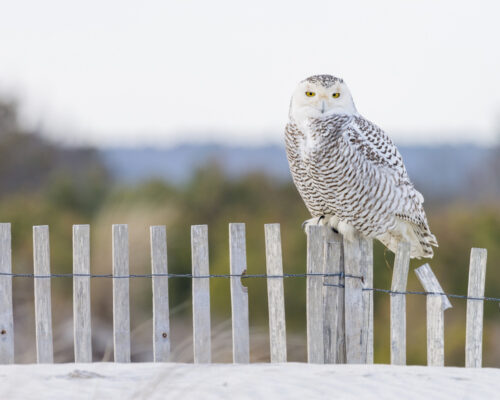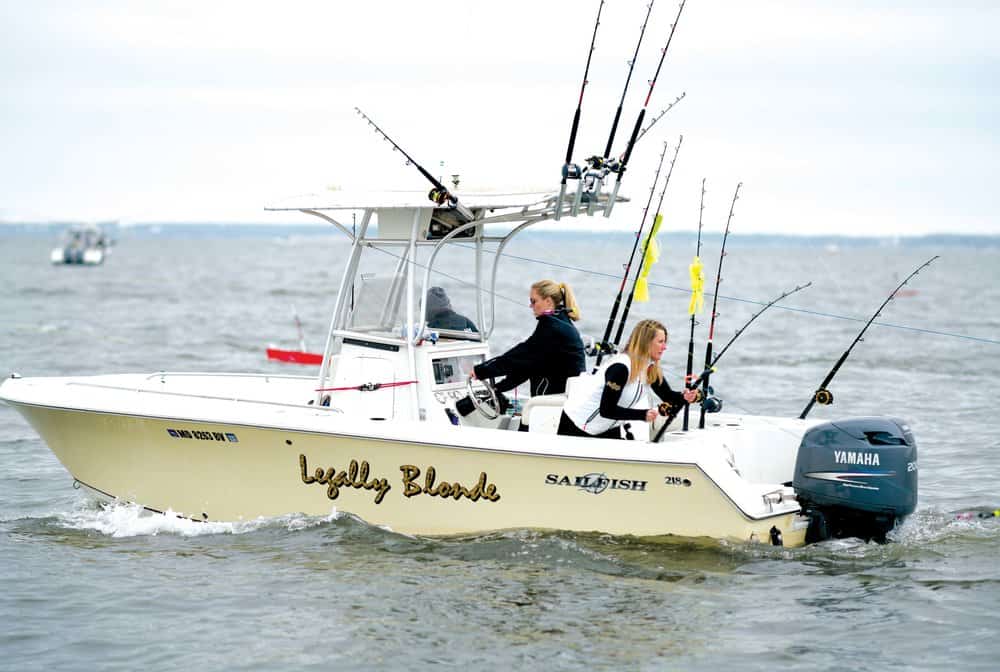Two Chesapeake fishing experts look back on 2017 and ahead to 2018.
Photo by Steve Droter/Chesapeake Bay ProgramVIRGINIA
by Beth Synowiec
2017 started off with the state-run Virginia Saltwater Tournament on the legislative chopping block in order to shift funding to general state expenses. The angling community rose up to remind everyone that the funding for the tournament comes from fishing license revenue, and the result is a world-class year-long event that brings boatloads of money to the waterfront from in-state and out-of-state anglers in pursuit of Virginia’s excellent fishing and hospitality. The tournament was saved and we all got a reminder of what a great thing it is.
COBIA
In June, Virginia opened its Cobia season under the cloud of a recreational fishing closure in federal waters by the National Marine Fisheries Service (NMFS). Virginia, which does not necessarily have to abide by the federal cobia rules in state waters, chose to tighten the rules to one cobia per angler and a total of three per boat with a minimum size of 40 inches with only one onboard over 50 inches and a June 1 to September 15 season.
The season opened with a decent amount of large cobia caught in the month of June. Eighty-four were entered into the tournament that month. The total registered for the season was 216. Reports indicate that while the catching was steady, the fish were smaller than in 2016. The open and closing dates may have influenced this decrease given our geographical location and the timing of the migration. Bluefish Rock, CBBT, Fisherman’s Island, York Spit light, Buckroe Pier, Windmill Point, Smith Point, Inner Middle ground, Plantation Light and Cape Henry provided a large percentage of the Cobia action.
Tautog
The 2017 saltwater season began with reports of tautog boat limits and some citation-size trophies including a 2017 tournament-leading 21-pound, 2-ounce beast caught by Michael Spiteri. Offshore wrecks such as the Triangles produced fish well in January and February with decent reports continuing into March and April, especially in the Bay.
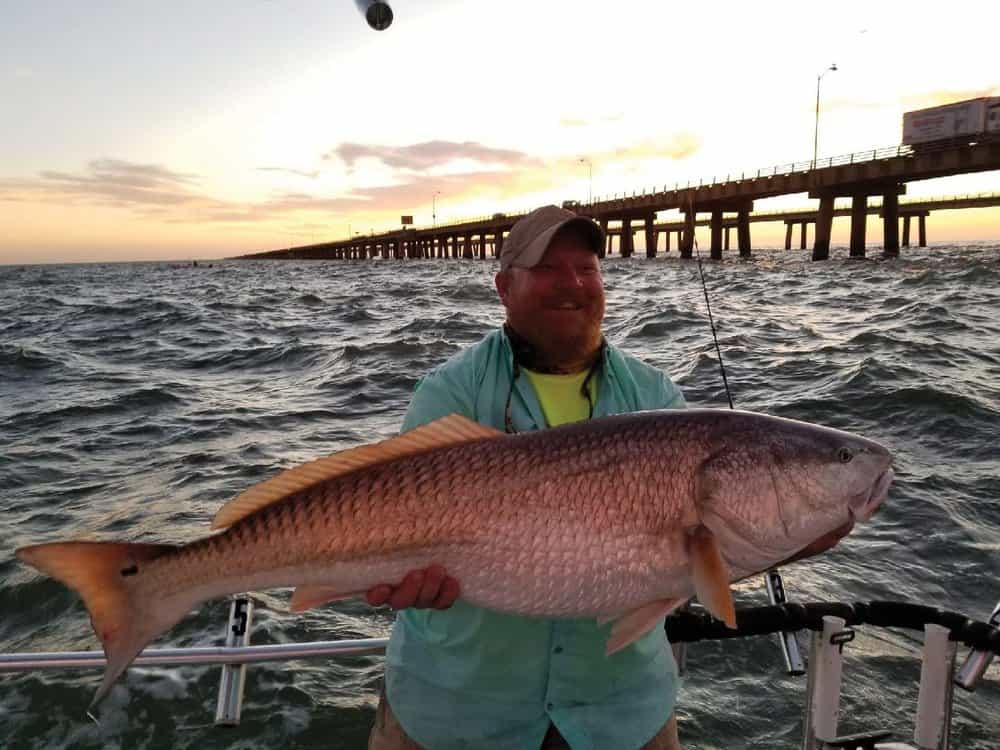
Red Drum
April delivered a remarkable big red drum bite, which continued through July, producing the highest number of Saltwater Tournament release citations since 2014. Fisherman’s Island, the Middle Grounds and the Eastern Shore remained popular for their spring and summer dependability. Fishing at the Chesapeake Bay Bridge Tunnel, High Rise and at Cape Henry was excellent through October. Sandbridge produced its final hurrah in mid-November.
Specks & Puppy Drum
Spring rewarded light-tackle anglers with robust speckled trout and puppy drum (red drum 16- to 32-inches) action along the grass lines, marshy areas and drop-offs within the inlets and near shore on both sides of the Bay. A cooler than normal August and September encouraged large schools of trout to gather, which provided fantastic fishing on nearly every trip. A larger class of fish surfaced during the fall season, and many trophy-sized fish came to the weigh-scales in October and November. Lynnhaven and Rudee inlets held plenty of keeper fish in the 18- and 22-inch range with multiple throwbacks in the mix. The James River, Long Creek and the Piankatank River are also worth mentioning for their dependable fishing action.
Sheepshead & Spades
From May through September, bait-fishing anglers experienced good sheepshead fishing along the Chesapeake Bay Bridge Tunnel islands and around the Chesapeake Light Tower. Seven citation spadefish were registered in 2017.
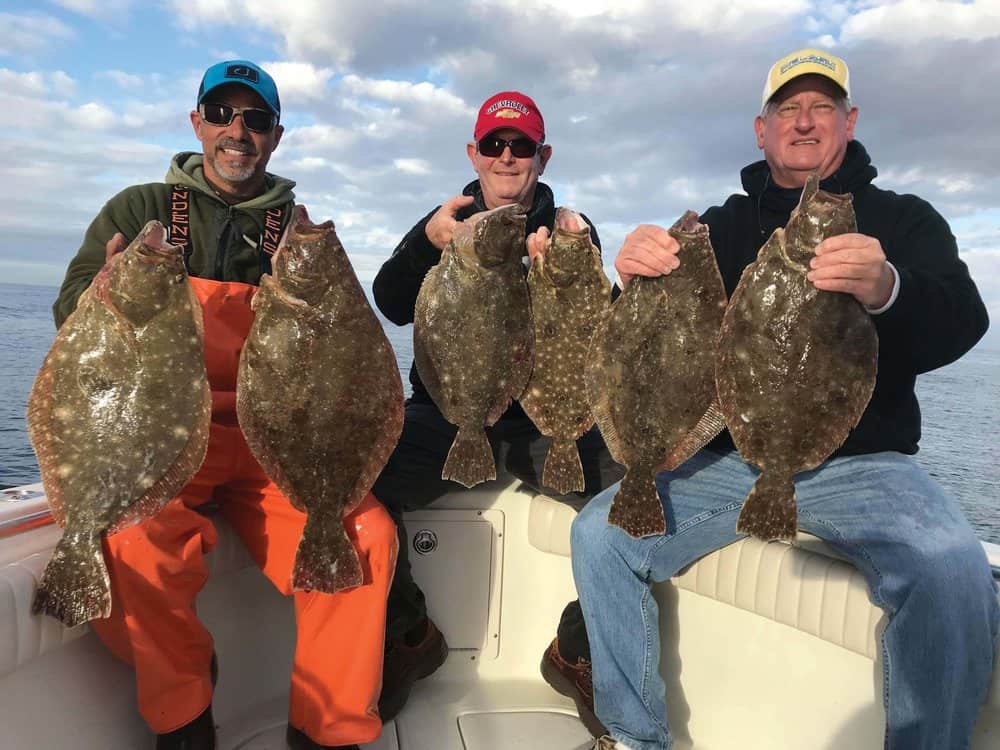
Flounder
The flounder bite was good in August with some heavier fish hauled in mostly from the Bay Bridge Tunnel, Eastern Shore and Chincoteague. Late-season bites occurred mostly over the offshore wrecks.
Striped Bass
October brought the fall rockfish season with reports of big fish caught around Old Plantation Light, Smith Point and Cape Charles. The third and fourth Bridge-Tunnel islands held some fish but the reports were nothing compared to the catches farther north in the Bay.
Bluewater
The 2017 white marlin bite and citation releases were about half of what we saw in 2016. Meanwhile, golden tilefish weight citations increased by 300 percent including a 58-pound state record set by Joshua Jung in the Norfolk Canyon. Blueline tilefish citations fell by nearly 50 percent and the season was closed on November 1.
For the first time ever, two citation grey triggerfish over six pounds were registered in the tournament. The 2017 state leader is David Waldon of Yorktown, who caught a 6-pound, 12-ounce fish in 100 fathoms of water fishing with Captain Jake Hiles.
Blue Catfish
Blue catfish are abundant in the Potomac River, according to Virginia Department of Game and Inland Fisheries biologist Bob Greenlee (VDGIF), but he reports a decline in the larger 40- to 50-pound fish in the James River. The tidal James and York are perfect he says for 20- to 30-pound cats.
Snakeheads
Fisheries biologist and VDGIF district manager John Odenkirk notes a slight decline in snakehead concentration in places that were first colonized, probably due to fishing pressure, but the overall population is expanding as their range expands. He also reminds us that it is illegal to keep a live snakehead. The same is true in the Potomac and other Maryland waters. However, in Virginia, they are not legal for commercial sale as they are in Maryland. Catch and release snakehead fishing is perfectly legal in Virginia, Maryland and the District of Columbia. “They are not an easy fish to catch,” he said. “You can sometimes see plenty of them, but then they don’t want to eat the bait.”
Predictions
There is no perfect science or method to the madness of predicting how and where the fishing action will occur. But it helps to look at cyclic patterns of the species, weather predictions, and tagging data before making a prognosis. So here it goes: Offshore, I anticipate a great year for big eye tuna, and I believe the “jack is back” with anticipation for a much better amberjack fishing over the offshore wrecks and around the Chesapeake Light and the South towers. White marlin, mahi-mahi and blackfin tuna fishing will be better than in 2017, and I anticipate a good year for black sea bass.
The inshore cobia fishery remains a mystery. We hope for a larger class of fish, of course. Meanwhile, I believe the big red drum anglers will have a decent year for catch and release spring and fall seasons. However, I’m not expecting the consistency we experienced in the summer of 2017. The puppy drum may not be as prevalent as they were in 2017, as many of the fish will have grown over the 26-inch slot size, and they will not be huddled in the inshore areas as much. There’s also a worry over the cold-stun effects of this cold winter. The same is true for the speckled trout, which suffer when the Bay and the Outer Banks freeze. We are all concerned about the flounder population status. Additionally, the weather people are predicting a lot of precipitation for 2018. This could lower the Bay salinity and make it hard for flounder to find meals, since they are sight feeders.
The Bay’s striper population seems to be pretty good, by all accounts. I’m optimistic that we will be able to lure them in as they travel through our part of the Bay.
Tight lines everyone!
Beth Synowiec is a Virginia Level 2 Master Angler, six-time State of Virginia expert angler, previous Norfolk Anglers Club and Virginia Beach Anglers Club Angler of the Year, Release Angler of the Year and Female Angler of the Year, and a Saltwater Sportsman ..National Saltwater Seminar Series presenter for the past three years.
MARYLAND
by Erik Zlokovitz
2017 was altogether a good fishing year in Maryland’s portion of the Bay with robust striper and white perch action throughout the seasons, a surprise showing of large blues, and some redfish and speck activity around Tangier Sound.
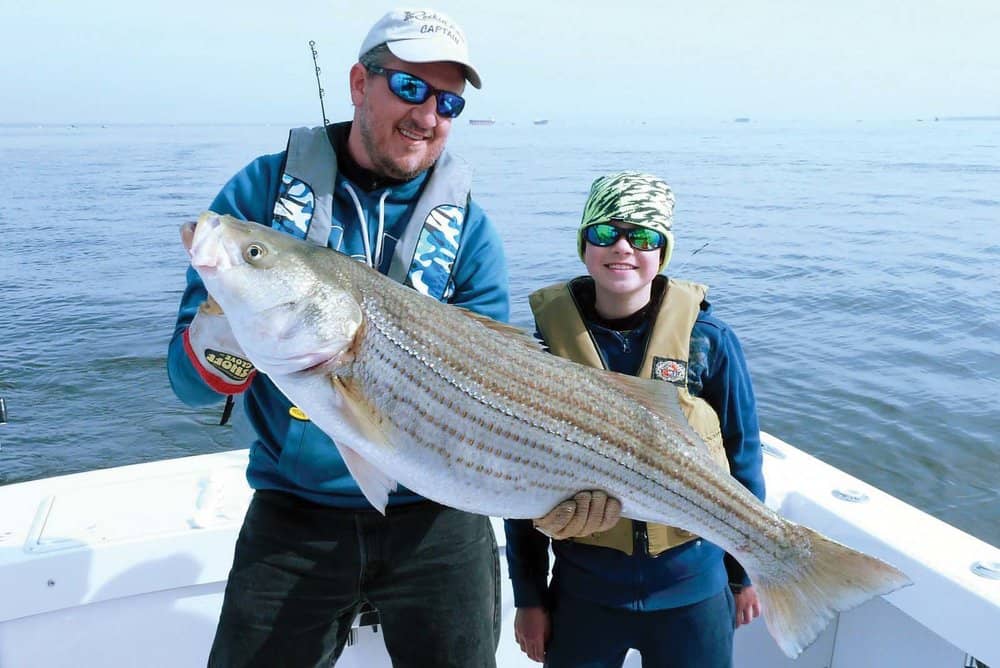
Striped Bass
The large 2011 year-class, which has fueled good fishing for summer resident fish during the last few years, turns seven this year. These fish may not quite make the 35-inch cut for the 2018 trophy season, but those who don’t joined the migratory stock should offer good opportunities when the size limit drops for the summer season. The dominant 2001 year-class and above-average 2003, 2005 and 2007 year-classes should offer plenty of big fish during trophy season. Maryland fishery scientists note that the summer resident rockfish season may not measure up to last year as we find ourselves in a gap between the large 2011 class, which will begin migrating out for the summer, and weaker 2012–2013 classes. The robust 2015 class will be on the small side, mostly below the legal minimum.
Therefore, anglers should be acutely aware of the importance of ethical catch and release fishing techniques and procedures, especially when the weather and waters are hot (see “Catch and Release” on page 64). Switch out single hooks for treble hooks on artificial lures, and crimp down barbs on the hooks to make it easier and quicker to release the fish. The added bonus is you will do less damage to the fish and potentially yourself in the process. Non-offset circle hooks, especially for live-line fishing, will also reduce release mortality. When catch and release fishing, be sure to handle the fish quickly, hold the fish horizontally for the photograph and never hold it by
the gills.
As the spring trophy season approaches, keen anglers will take advantage of nice weather to enjoy some pre-season catch and release trolling. Prior to the spring trophy season, stinger hooks are banned and there’s a limit of six rods per boat. Trolling lures have evolved over the last few years, with the old spoons being replaced by parachute jigs, tandem bucktail rigs and umbrella rigs.
The spring trophy fishery tends to last longer during cold, wet springs, with the larger females hanging around until Memorial Day weekend or early June during those years. Hot and dry spring weather will push the large females out of the Bay earlier, with most of the cows gone by mid-May. The fish will be in the upper portion of the water column, cruising five to 20 feet below the surface near the main north-south shipping channel. Double bucktail rigs and parachutes jigs with nine-inch plastic shads in white or chartreuse dominate the fishery. Last year’s trophy fishery got off to a slow start due to below-average water temps and stained water with debris coming down the Susquehanna River and the upper Bay. Moderate temperatures with less-stained water and a slow warming trend will result in a longer and more productive trolling season. During my years as a striped bass biologist sampling catches at the docks and boat ramps, I found the most consistent action was from Deale south to Solomons Island on the Western Shore with a good bite near Tilghman Island on the Eastern Shore. The ports of Crisfield and Solomons will get the first of the northbound migratory fish in the early part of the season, and the last of the exiting “downrunners” near the end of the trophy season.
While most of the fishing will be from boats, shore casters have had success at Matapeake, Sandy Point and other Bayside locations using blood worms and cut-fish chunk-baits such as menhaden fished on the bottom. A popular chunking fishery has developed around Hackett’s Bay and Dolly’s Lump just south of the Bay Bridge. This fishery is different from the chumming fishery during summer in that large chunk-baits and menhaden heads are fished on the bottom for large fish. Light-tackle jiggers have also become skilled at locating suspended striped bass feeding on large bait during spring.
The Susquehanna Flats catch-and-release fishery in late March through May has not produced the large numbers of fish that were encountered in the late 1990s and early 2000s, but remarkably large fish are still staging on the flats and especially up the Susquehanna River to the edge of the legal fishing area near the Lapidum boat ramp. It’s all catch-and-release up there until May 16.
By early June, the striped bass fishery will transition to resident adult males as the large females will leave the Bay for cooler, saltier northern waters. The summer fishery should be strong, based on recent trends and dominant 2011 and 2015 year-classes. Trollers will downsize lures and light-tackle casters and jiggers will find fish on structure at the Bay Bridge pilings and perhaps around Poplar Island and Eastern Bay. Trollers will downsize lures and light-tackle casters and jiggers will find fish on structure at the Bay Bridge pilings and breaking fish near Poplar Island. In recent years, a strong summer live-line bait and chumming fishery has developed above the Bay Bridge at the mouth of the Magothy, Podickory and Love Points.
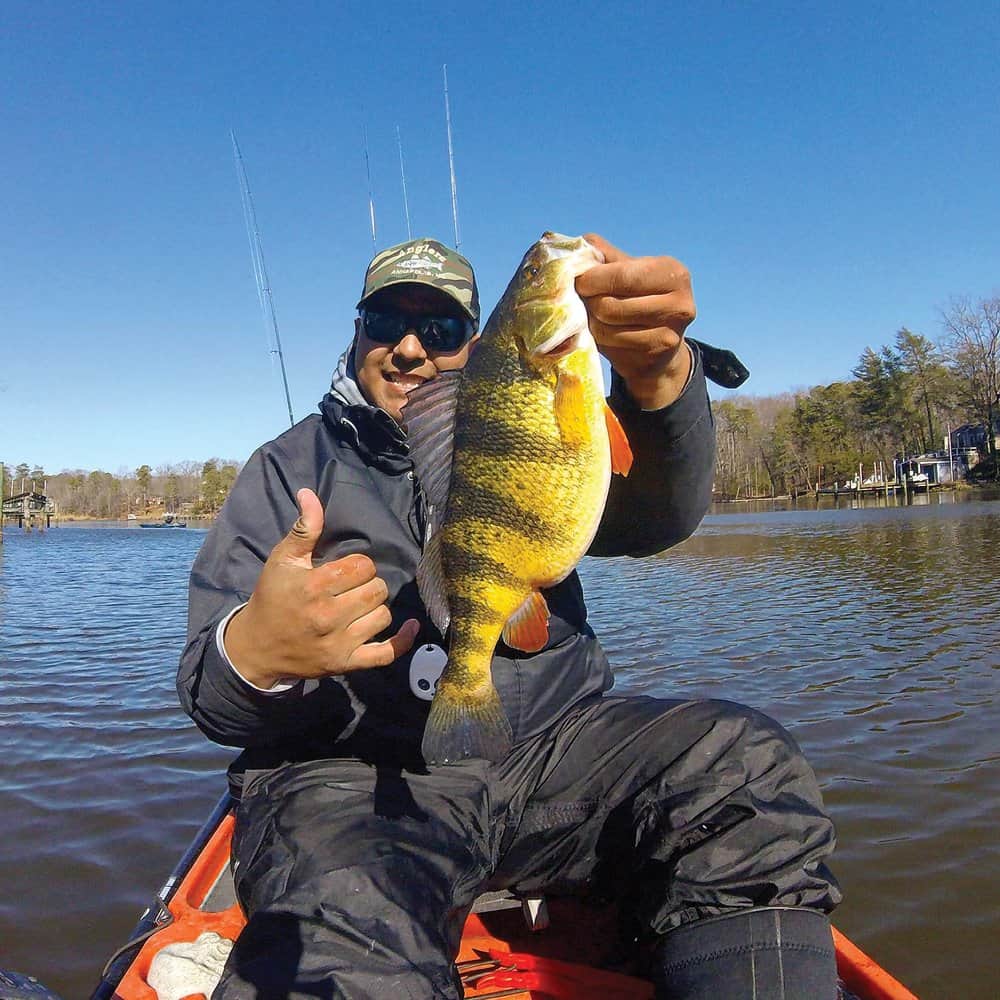
Yellow Perch
Yellow perch populations have had good spawning years in 2011, 2014 and 2015. The 2011 year-class is producing jumbo perch for anglers, but the dominant catch this year will consist of the smaller, eight-inch, 2015 year-class. Unfortunately, the minimum size is nine inches with a limit of 10 per day. These fish, along with the 2014 year-class should grow to become jumbos in the following years. The patient angler will be rewarded by occasional pan-size perch from the very large 2011 year-class.
Time-tested lures and baits are shad darts or small 1/16- or 1/32-ounce lead-heads tipped with grass shrimp and twister tails, or live minnows fished on top & bottom rigs or single-dropper-loop rigs near the bottom. These same lures and baits will often work for white perch, pickerel and crappie in the same tidal waters.
Shad
The hickory and American shad runs will occur in April and May in the Potomac River, Patuxent River, Susquehanna River and the Eastern Shore. The base of the Conowingo Dam is concentration point for American shad and hickory shad. Hickory shad have a cult following in the Deer Creek area due to their jumping ability as “poor man’s tarpon” and catchability on light spinning gear and fly rods. I’ve found that hickory shad will hit small twister tail jigs and spoons in addition to the standard shad darts.
Bluefish & Spanish Mackerel
Large spring-run bluefish weighing more than eight pounds have not made a major appearance in the Chesapeake Bay since the late 1980s, but there was a strong run of them in the Ocean City and Delaware Bay area last April and May. A summer combination of low rainfall, high salinity and baitfish may draw bluefish and Spanish mackerel up as far as Annapolis, spicing things up for light-tackle casters and trollers using small spoons and surgical tubes or hoses.
Spot & croaker
Anglers have been working harder in recent years to find catchable concentrations of spot and croaker. Both species are prone to seasonal variance due to weather and oceanographic conditions, which affect the success of the spawn and the abundance of the adults from year to year.
Both species are ocean-shelf spawners. They are come up the Bay to feed and avoid predation. Thus, if there is a shrinking of the geographic range, Maryland will notice a drop in catch before Virginia and the Potomac the southern Bay jurisdictions (PRFC and VMRC). Spot production has been very low recently, which is the primary reason for their decline. Croaker has had average to above average year classes in 2012 and 2013, and we are somewhat surprised we did not see more of those fish in 2016, since they recruit to the fishery at three- to four- years of age.
Flounder (summer flounder)
The summer flounder fishery has not been very productive in the Chesapeake Bay compared with 10 to 15 years ago. Historic flounder hot spots in the mid-Bay such as Poplar Island, Thomas Point, and the Hill have been disappointing lately. A much more productive summer fishery for large flounder has developed offshore off Ocean City on the offshore artificial reefs and shipwrecks. The most productive baits are strip baits and squid fished on conventional rigs or large bucktails. The more traditional back-bay spots behind Ocean City, such as the Thoroughfare and the Route-50 Bridge also produce flounder, but these are a smaller grade of fish when compared with the ocean run flounder.
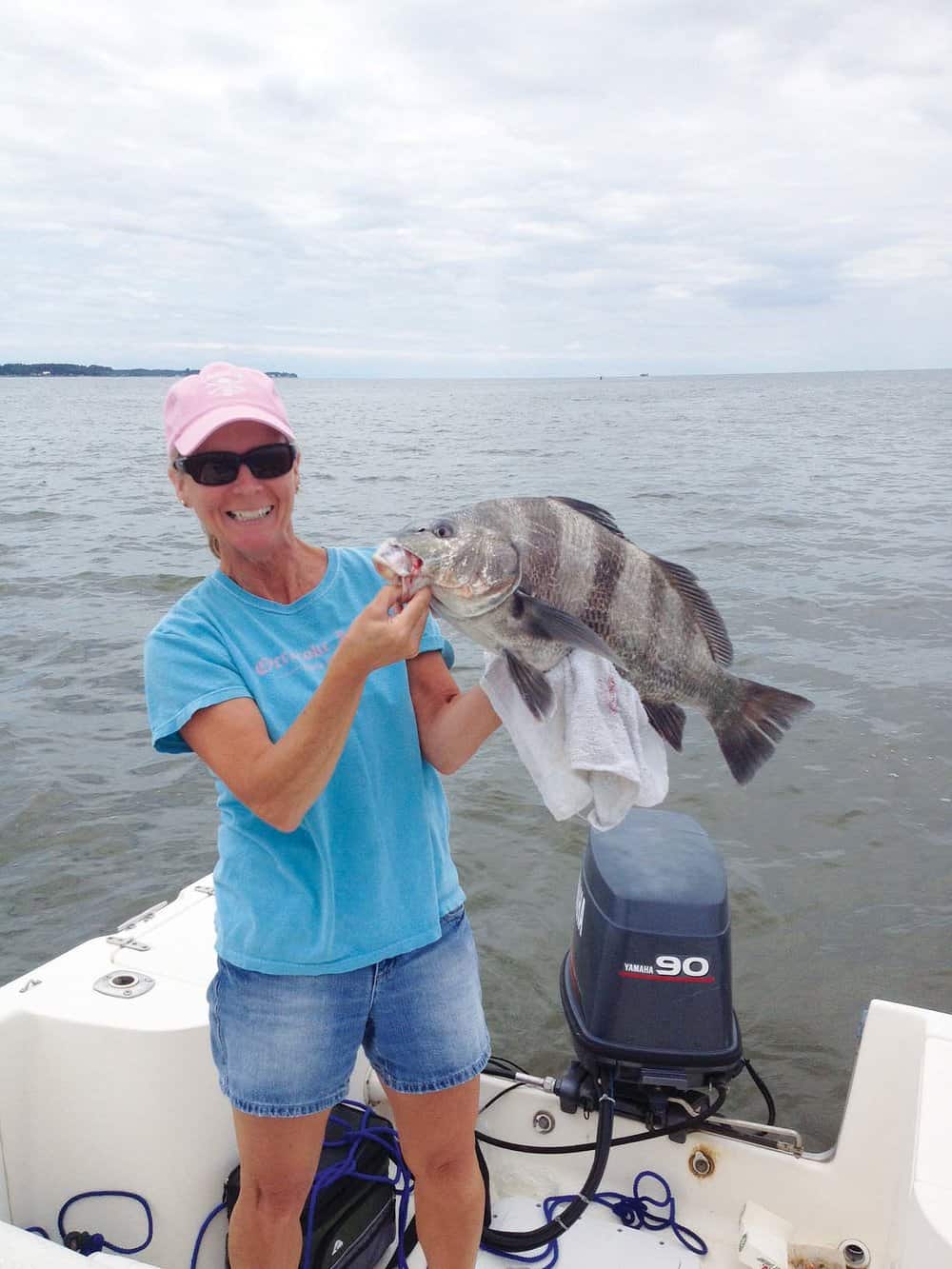
Black drum
The black drum fishery was historically a big event for the charter and private boat fleet in late May around the Stone Rock. The hot bait was a soft crab drifted in front of a school of drum after being marked on bottom with a fish finder. The Stone Rock fishery has been a smaller event in recent years, but anglers still encounter them, ranging from smaller “puppy” drum (often confused with sheepshead) to 60- to 70-pound beasts. Some of these fish are caught on artificial lures, typically on plastic jigs being fished deep for rockfish, blues or weakfish. Locations where black drum have been caught are Poplar Island, lower Choptank River and Eastern Bay, with a few strays going all the way up to Belvedere Shoals, north of the Bay Bridge.
Red Drum & Specks
In recent years, a productive light-tackle fishery has developed for speckled trout and red drum. This fishery is centered mainly in the shallows, cuts, holes and drop-offs of the lower Eastern Shore and Tangier Sound, with some activity also around Poplar Island, Kent Island and Eastern Bay. We have also seen an interesting trend of young speckled trout and “puppy” red drum in the western shore tidal rivers near Annapolis, including the Severn and South in August through early October. These fish are sometimes caught by light-tackle anglers in the shallows targeting white perch.
Weakfish
Weakfish, also known as gray trout, have declined over the last 10 years, but did make a resurgence last year in the lower Bay near Point Lookout. When we last had a good weakfish bite in the middle and upper Bay, the schools ranged from Calvert Cliffs to the Bay Bridge, often on the bottom in 20- to 80-feet of water under feeding schools of striped bass. Heavy jigging spoons such as Stingsilvers and Crippled Herrings, and light, feather-jigs tied on a leader above a trout-bomb were the most productive lures for the fall jigging fishery. Bloodworms and squid on top-bottom rigs while fishing for croaker and spot can also deliver a grey trout surprise.
Blue Cats
The population explosion of invasive blue catfish in the Potomac River has led to a robust fishery from the Route 301 Bridge up to Fort Washington in the river and the tributaries. The fish are caught almost year-round on cut bait from boats and from shore.
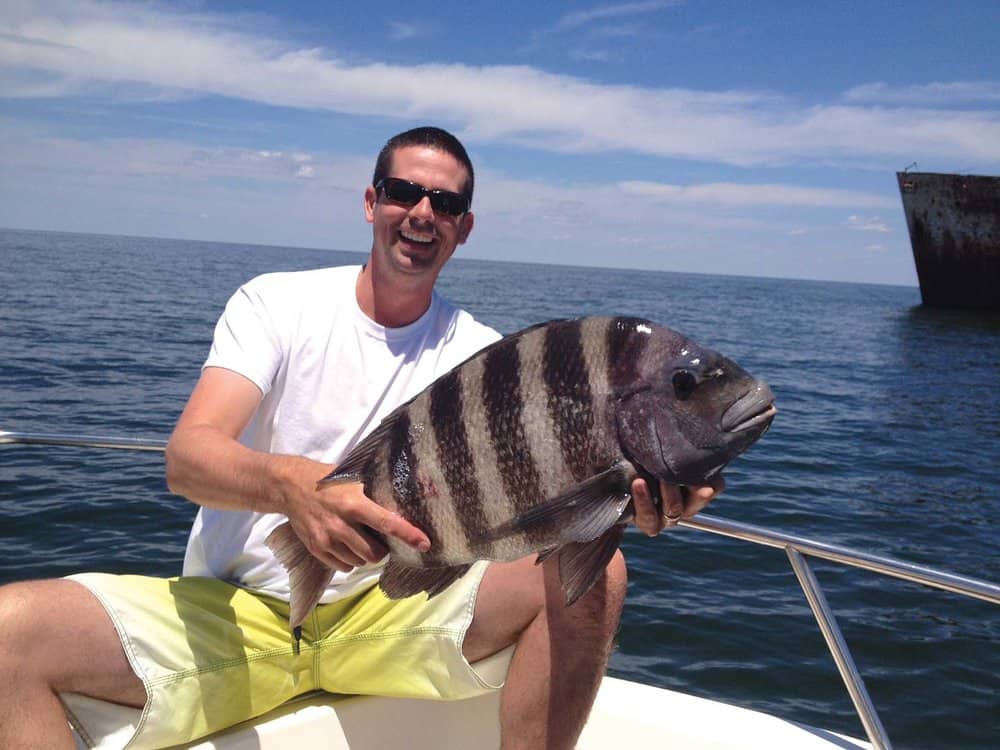
Sheepshead
2017 was an excellent year for sheepshead around the Ocean City Inlet jetties, artificial reefs and shipwrecks. Best baits are sand fleas and green crabs.
Erik Zlokovitz is a fisheries biologist and the recreational fishing access and outreach coordinator at the Maryland Department of Natural Resources Fishing and Boating Services Division.


